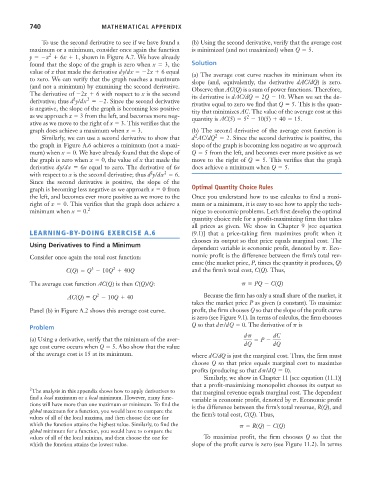Page 766 - Microeconomics, Fourth Edition
P. 766
BMappAMathematicalAppendix.qxd 8/17/10 1:10 AM Page 740
740 MATHEMATICAL APPENDIX
To use the second derivative to see if we have found a (b) Using the second derivative, verify that the average cost
maximum or a minimum, consider once again the function is minimized (and not maximized) when Q 5.
2
y x 6x 1, shown in Figure A.7. We have already
found that the slope of the graph is zero when x 3, the Solution
value of x that made the derivative dy/dx 2x 6 equal (a) The average cost curve reaches its minimum when its
to zero. We can verify that the graph reaches a maximum slope (and, equivalently, the derivative dAC/dQ) is zero.
(and not a minimum) by examining the second derivative. Observe that AC(Q) is a sum of power functions. Therefore,
The derivative of 2x 6 with respect to x is the second its derivative is dAC/dQ 2Q 10. When we set the de-
2
2
derivative; thus d y/dx 2. Since the second derivative rivative equal to zero we find that Q 5. This is the quan-
is negative, the slope of the graph is becoming less positive tity that minimizes AC. The value of the average cost at this
as we approach x 3 from the left, and becomes more neg- quantity is AC(5) 5 10(5) 40 15.
2
ative as we move to the right of x 3. This verifies that the
graph does achieve a maximum when x 3. (b) The second derivative of the average cost function is
2
2
Similarly, we can use a second derivative to show that d AC/dQ 2. Since the second derivative is positive, the
the graph in Figure A.6 achieves a minimum (not a maxi- slope of the graph is becoming less negative as we approach
mum) when x 0. We have already found that the slope of Q 5 from the left, and becomes ever more positive as we
the graph is zero when x 0, the value of x that made the move to the right of Q 5. This verifies that the graph
derivative dy/dx 6x equal to zero. The derivative of 6x does achieve a minimum when Q 5.
2
2
with respect to x is the second derivative; thus d y/dx 6.
Since the second derivative is positive, the slope of the
graph is becoming less negative as we approach x 0 from Optimal Quantity Choice Rules
the left, and becomes ever more positive as we move to the Once you understand how to use calculus to find a maxi-
right of x 0. This verifies that the graph does achieve a mum or a minimum, it is easy to see how to apply the tech-
minimum when x 0. 2 nique to economic problems. Let’s first develop the optimal
quantity choice rule for a profit-maximizing firm that takes
all prices as given. We show in Chapter 9 [see equation
LEARNING-BY-DOING EXERCISE A.6 (9.1)] that a price-taking firm maximizes profit when it
chooses its output so that price equals marginal cost. The
Using Derivatives to Find a Minimum
dependent variable is economic profit, denoted by p. Eco-
Consider once again the total cost function: nomic profit is the difference between the firm’s total rev-
enue (the market price, P, times the quantity it produces, Q)
3
2
C(Q) Q 10Q 40Q and the firm’s total cost, C(Q). Thus,
The average cost function AC(Q) is then C(Q)/Q: p PQ C(Q)
2
AC(Q) Q 10Q 40 Because the firm has only a small share of the market, it
takes the market price P as given (a constant). To maximize
Panel (b) in Figure A.2 shows this average cost curve. profit, the firm chooses Q so that the slope of the profit curve
is zero (see Figure 9.1). In terms of calculus, the firm chooses
Q so that dp/dQ 0. The derivative of p is
Problem
dp dC
(a) Using a derivative, verify that the minimum of the aver- P
age cost curve occurs when Q 5. Also show that the value dQ dQ
of the average cost is 15 at its minimum. where dC/dQ is just the marginal cost. Thus, the firm must
choose Q so that price equals marginal cost to maximize
profits (producing so that dp/dQ 0).
Similarly, we show in Chapter 11 [see equation (11.1)]
that a profit-maximizing monopolist chooses its output so
2 The analysis in this appendix shows how to apply derivatives to that marginal revenue equals marginal cost. The dependent
find a local maximum or a local minimum. However, many func- variable is economic profit, denoted by p. Economic profit
tions will have more than one maximum or minimum. To find the is the difference between the firm’s total revenue, R(Q), and
global maximum for a function, you would have to compare the
values of all of the local maxima, and then choose the one for the firm’s total cost, C(Q). Thus,
which the function attains the highest value. Similarly, to find the p R(Q) C(Q)
global minimum for a function, you would have to compare the
values of all of the local minima, and then choose the one for To maximize profit, the firm chooses Q so that the
which the function attains the lowest value. slope of the profit curve is zero (see Figure 11.2). In terms

